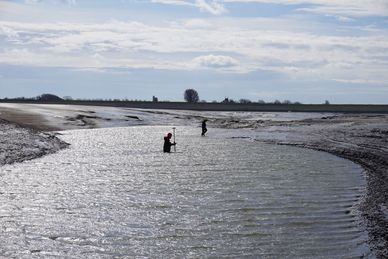PR 00297: verschil tussen versies
Geen bewerkingssamenvatting |
Geen bewerkingssamenvatting |
||
| Regel 5: | Regel 5: | ||
At three locations in the Westerschelde estuary (Baalhoek, Knuitershoek and Perkpolder) experiments have been carried out with innovative measuring techniques to gain a better understanding of factors that influence the functioning of tidal ecosystems. Data from nine key parameters were collected: (1) bird numbers, (2) benthos as bird food, (3) benthos as bioturbator, (4) medium-scale morphology, (5) large-scale morphology, (6) short-term (daily) changes in sediment height, (7) soil density, (8) hydrodynamics: currents / waves and (9) sediment concentrations in water. | At three locations in the Westerschelde estuary (Baalhoek, Knuitershoek and Perkpolder) experiments have been carried out with innovative measuring techniques to gain a better understanding of factors that influence the functioning of tidal ecosystems. Data from nine key parameters were collected: (1) bird numbers, (2) benthos as bird food, (3) benthos as bioturbator, (4) medium-scale morphology, (5) large-scale morphology, (6) short-term (daily) changes in sediment height, (7) soil density, (8) hydrodynamics: currents / waves and (9) sediment concentrations in water. | ||
{{Project config}} | {{Project config}} | ||
{{Project | {{Project | ||
| Regel 19: | Regel 18: | ||
|Show navigation tree=Ja | |Show navigation tree=Ja | ||
|Show new page button=Ja | |Show new page button=Ja | ||
|Show sub projects= | |Show sub projects=Nee | ||
|Show participants=Nee | |Show participants=Nee | ||
|Show sources=Ja | |Show sources=Ja | ||
Versie van 11 nov 2020 14:32
The Netherlands has laid down guidelines for nature conservation and biodiversity in the Natura2000 Management Plan for Delta Waters. The Dutch waters and delta areas make up two-thirds of the Natura2000 areas and form an important habitat for coastal breeding birds and are indispensable for migratory birds as a resting area and place to forage. For nature management to be more effective, monitoring the dynamics of estuarine nature in the delta management cycle is of great importance. It offers public professionals the opportunity to adapt system designs and/or system interventions.
For project monitoring conventional measuring techniques are used which are often labour-intensive and therefore costly. The aim of this project is to investigate whether monitoring nature restoration projects can be made more efficient. The key question is whether the use of new measuring techniques will enable more or different types of data to be collected at lower cost, over larger areas and with better temporal resolutions. In other words, more understanding of the system.
At three locations in the Westerschelde estuary (Baalhoek, Knuitershoek and Perkpolder) experiments have been carried out with innovative measuring techniques to gain a better understanding of factors that influence the functioning of tidal ecosystems. Data from nine key parameters were collected: (1) bird numbers, (2) benthos as bird food, (3) benthos as bioturbator, (4) medium-scale morphology, (5) large-scale morphology, (6) short-term (daily) changes in sediment height, (7) soil density, (8) hydrodynamics: currents / waves and (9) sediment concentrations in water.

